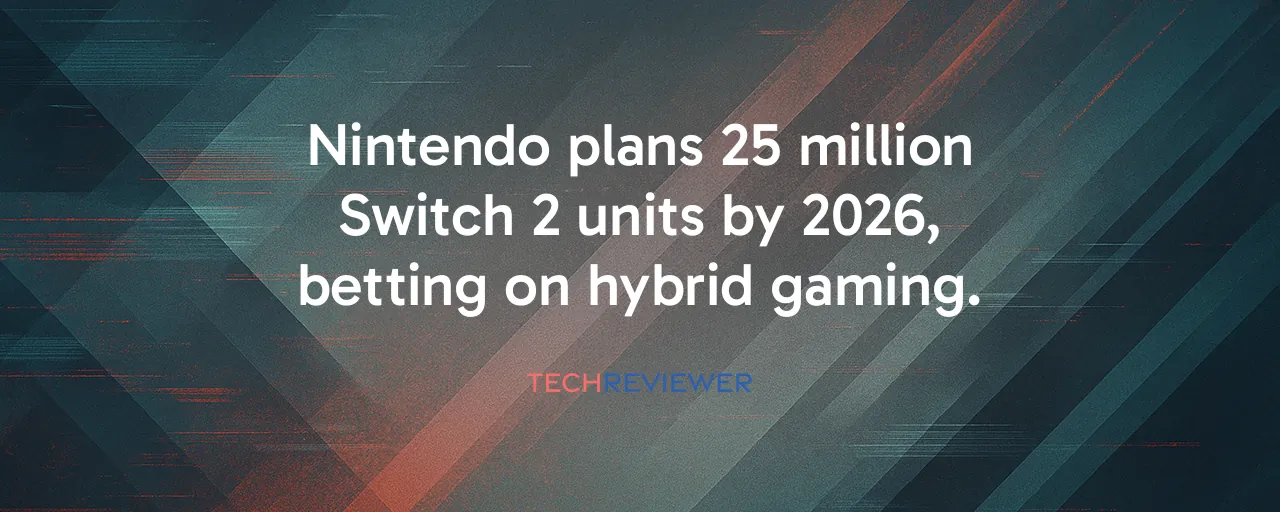A Bold Leap for Nintendo's Hybrid Vision
Nintendo's decision to produce 25 million Switch 2 consoles by March 2026 isn't just about meeting demand. It's a declaration that the hybrid gaming model, blending portable and home console experiences, remains a winning formula. Since its June 5, 2025 launch, the Switch 2 has smashed records, selling 3.5 million units in just four days and hitting 5.82 million by July's end. That's faster than any console in history, outpacing even the PlayStation 4 by 5 percent in its first three months. This production surge reflects Nintendo's confidence that its vision will keep players hooked through the holiday rush and beyond.
What makes this move stand out? Nintendo isn't playing it safe. The company's banking on sustained demand, fueled by blockbuster titles like Pokemon Legends Z-A and a beefy hardware upgrade. The Switch 2's custom Nvidia Tegra T239 chip, with ray tracing and DLSS, delivers visuals that rival home consoles while staying portable. For players, this means smoother gameplay in titles like Mario Kart World, which pops in 4K HDR when docked. Nintendo's bet is clear: the future of gaming lies in flexibility, and they're ready to flood the market to prove it.
Lessons From the Past: Switch 2 vs. Original Switch
Flash back to 2017, when the original Nintendo Switch launched to massive hype but crippling shortages. Component bottlenecks, particularly flash memory and LPDDR4 RAM, left shelves empty and frustrated buyers turning to scalpers. Nintendo sold 17.79 million units in its first 13 months but could have done more with better supply planning. Learning from that chaos, Nintendo stockpiled Switch 2 inventory before its June 2025 debut, ensuring 3.5 million units flew off shelves in days. By July, sales hit 5.82 million, with stock stabilizing faster than in 2017.
Contrast that with Sony's PlayStation 5 launch in 2020, which suffered shortages well into 2022 due to semiconductor woes. Nintendo's proactive approach paid off, with US retailers like Best Buy and Walmart reporting steady stock by August 2025. The lesson? Preparation matters. Nintendo's massive production target shows they're not repeating past mistakes, aiming to meet demand head-on while competitors scramble. But it's not flawless. Early adopters griped about the LCD screen's ghosting compared to the Switch OLED's crisp display, a trade-off for cost control.
Why Nintendo's Bet Is Paying Off
The Switch 2's success isn't just about numbers; it's about rewriting gaming's playbook. With 8.67 million software units sold by July 2025, titles like Pokemon Legends Z-A, with its real-time battle system, show off hardware that older Switches couldn't handle. The 7.9-inch 1080p screen and 256 GB storage make handheld gaming feel premium, while backward compatibility lets players dive into the original Switch's massive library without repurchasing. For families, it's a no-brainer. Imagine a kid playing Mario Kart World on the go, then docking it for a living room showdown.
Nintendo's manufacturing partners, like Hon Hai and Foxconn, are ramping up to meet this demand, but it's not without risks. Trade tensions, like the 20 percent tariffs on Vietnamese goods, could spike costs. Yet Nintendo's stock has soared 40 percent in 2025, signaling investor confidence. In contrast, the Xbox Series X has maintained its market position, though the Switch 2's momentum has reshaped overall console sales dynamics. Nintendo's focus on hybrid gaming gives it an edge, appealing to commuters and families alike, while competitors stick to traditional consoles.
Challenges and Voices of Doubt
Not everyone's sold on Nintendo's strategy. The 449-dollar price tag raises eyebrows, especially for families eyeing multiple units or original Switch owners debating an upgrade. Some argue the PlayStation 5, at a similar price, offers more raw power for home setups. Others point to the Steam Deck, which taps into PC game libraries for a different kind of flexibility. The Switch 2's LCD screen, a step back from the OLED model, and unchanged battery life of 2 to 6.5 hours have sparked grumbling on social media, with players wanting more polish for the price.
Then there's the game key card debate. These physical licenses require downloads, frustrating collectors who value true ownership. Developers face tough calls too, balancing native rendering with DLSS upscaling to hit performance targets. Despite these hurdles, Nintendo's track record suggests they'll adapt. The company's already hinting at future exclusives like The Legend of Zelda to keep momentum, and analysts predict 20 million units sold by March 2026, a figure that could climb higher if holiday sales explode.
What's Next for Nintendo's Gaming Empire
Nintendo's goal of producing 25 million units goes beyond short-term success. It lays the foundation for the company's future strategy. The holiday season, with Pokemon Legends Z-A dropping October 16, 2025, will test whether demand holds. Historically, Pokemon titles drive hardware sales, and this one's real-time battles could lure new buyers. Looking ahead, analysts see the Switch 2 rivaling the original's 153 million lifetime sales, especially with potential OLED revisions or a Switch 2 Lite down the line. Third-party support, like Cyberpunk 2077's ray-traced glow-up, shows developers are all-in.
But challenges loom. Trade policies could disrupt manufacturing in Vietnam and China, and environmental concerns around electronic waste nag at the industry. Nintendo's leaning on recyclable packaging and backward compatibility to soften the blow, but scaling up to 25 million units raises questions about sustainability. For now, Nintendo's riding high, proving that a console that fits in your backpack can still dominate living rooms worldwide. Players, developers, and retailers are watching closely, Nintendo's not just building consoles; it's shaping gaming's future.
